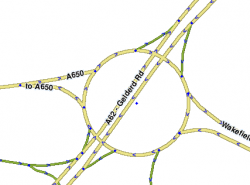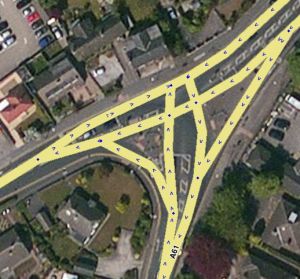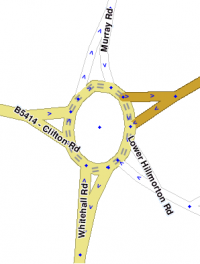| Line 18: | Line 18: | ||
* Drag main 2-way segments to the centre | * Drag main 2-way segments to the centre | ||
* Draw new roundabout | * Draw new roundabout | ||
Small and mini-roundabouts should be drawn as large as possible. Any with a radius much less than 10m will not be visible on the client, so aim to get them close to this size if you can. | Small and mini-roundabouts should be drawn as large as possible. Any with a radius much less than 10m will not be visible on the client, so aim to get them close to this size if you can. | ||
| Line 25: | Line 23: | ||
'''Naming Roundabouts''' | '''Naming Roundabouts''' | ||
After drawing a new roundabout, it is important to '''change the road type''' to that of highest connecting road, and '''set the address'''. ''If the address is not set correctly, the new segments will be drawn in <span style="color: red;">red</span>'' and will not be visible in the client. | |||
If the roundabout does have a proper, signposted name, then this can be labeled using a 'Junction/Intersection' type landmark that fills the centre of the roundabout. | To aid navigation instructions, roundabouts should typically remain '''unnamed'''. If the roundabout does have a proper, signposted name, then this can be labeled using a 'Junction/Intersection' type landmark that fills the centre of the roundabout. | ||
'''Common Issues With Roundabouts''' | '''Common Issues With Roundabouts''' | ||
Revision as of 10:08, 10 July 2012
Introduction
This forms part of UK Editing Best Practice. Editors are encouraged to follow these guidelines.
Junctions
Junctions should generally be drawn as simply as possible. T-junctions and cross roads are usually best as single 2-way roads that are connected with a single node. Only when there are large turning lanes and restrictions should a more complicated layout be considered.
The UK basemap has a lot of junctions that have been split into 1-way roads just because there's some painted chevrons in the middle of the road. This is completely unnecessary, and should be removed where they can.
Roundabouts
Roundabouts should also be drawn as simply as possible, with single 2-way segments for each connecting road. Much of the UK basemap has pairs of 1-way entry and exit segments which are not really necessary. If you have an opportunity to remove these when rebuilding a roundabout, please do so. They will look much better on the client.
Steps for redoing a roundabout:
- Delete roundabout and 1-way "V"s
- Drag main 2-way segments to the centre
- Draw new roundabout
Small and mini-roundabouts should be drawn as large as possible. Any with a radius much less than 10m will not be visible on the client, so aim to get them close to this size if you can.
Naming Roundabouts
After drawing a new roundabout, it is important to change the road type to that of highest connecting road, and set the address. If the address is not set correctly, the new segments will be drawn in red and will not be visible in the client.
To aid navigation instructions, roundabouts should typically remain unnamed. If the roundabout does have a proper, signposted name, then this can be labeled using a 'Junction/Intersection' type landmark that fills the centre of the roundabout.
Common Issues With Roundabouts
- If a roundabout doesn't have a central node or === symbols around the edge, then it is not a proper roundabout. The client will give 'keep left' and 'keep right' instructions instead of 'take the nth exit'. These junctions need to be deleted and redrawn.
- If two entry and exit segments share the same junction on the roundabout, the exit will not be counted when entering at that junction. Entry and exit segments should always be connected via separate junctions.
- Sometimes the client will say "Take the 0th exit" for a roundabout. This is often caused by an invisible node on or within the junction, and can only be deleted via the old editor.
Special Roundabouts
Sometimes a roundabout will get modified to change its shape and function, such that it is no longer a simple a roundabout.

One such example is the "Hamburger Roundabout", where the main carriageway goes straight through the middle of the junction. This should be drawn as if the main road was an over pass, with short ramps connecting it to the roundabout. The example here is near M62 Junction 27 (Leeds).
Some roundabouts get modified so much that they can no longer be considered roundabouts at all. Here are some examples:
- M62 Junction 31 (Castleford)




